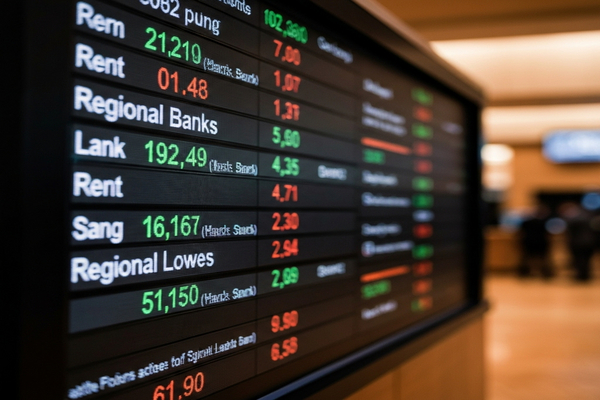
Regional banks drag markets lower. Zions Bancorp (NASDAQ:ZION) reported a $50 million third quarter loss driven by souring California loans and that news weighed on bank shares across the board. The S&P 500 slipped about 1% while the Nasdaq fell 0.85%. U.S. Treasury yields dropped below 4%, the dollar weakened and gold hit fresh highs. This matters now because banks are setting investor sentiment for the coming session, policy makers are on the record ahead of a key Fed meeting and safe haven flows are accelerating. Short term, traders are pricing renewed rate cut odds. Longer term, the episode highlights credit sensitivity in regional lenders and the rising role of safe assets for central banks globally.
Market snapshot
Late session moves set the tone for the open
U.S. equities closed lower after bank losses and macro headlines undercut a tentative rally. The S&P 500 ended the day down roughly 1% and the Nasdaq lost about 0.85%. The S&P Banks index fell 3.5% while the KBW regional bank index plunged about 7%. Traders reacted to an earnings-related loss at Zions Bancorp (NASDAQ:ZION) and broader worries over regional loan quality.
Fixed income moved decisively toward lower yields. The 10 year U.S. Treasury yield finished below 4%, around 3.9707%, slipping more than seven basis points on the day. The drop in yields reinforced a stronger bid for safe assets and supported gold’s climb to a new high for the fourth session in a row.
Bank stress and credit signals
Losses at smaller lenders are testing market tolerance
Zions Bancorp disclosed a $50 million quarterly loss tied to troubled California loans. That was enough to erase recent gains from better bank earnings from the largest institutions earlier in the week. Regional banks underperformed sharply and the move spilled into broader financials. The KBW regional index finished with a steep decline that more than offset a prior session rally.
Market participants will be watching loan charge trends and provisions that regional banks disclose in coming reports. The episode underscores the sensitivity of smaller banks to localized real estate stress and to cyclical credit risks. In the short run, investors are weighing earnings signals against the supportive backdrop from big-bank results. Over the longer term, persistent regional weakness could affect credit availability in local markets and corporate lending conditions across the United States.
Policy signals, the dollar and yields
Central bank comments are shaping expectations for rates and capital flows
The dollar logged a third straight down session against major currencies including the euro, yen and Swiss franc. Dollar/yen fell after comments from Bank of Japan assistant governor Seiichi Shimizu who advised caution in normalizing policy because the economy may react differently to positive interest rates. On the U.S. side Fed Governor Christopher Waller expressed support for an additional interest rate cut in October based on mixed job market signals.
Those remarks fed expectations that the Federal Reserve could ease policy sooner than some had expected. Fed speakers are scheduled through the week and the blackout window ahead of the policy meeting starts on Saturday. That raises the bar for fresh guidance, with the last public speaker before the quiet period expected on Friday. Lower rate expectations pushed Treasury yields down and helped real assets and foreign markets that typically respond to weaker dollar moves.
Commodities and safe havens
Gold rallies, oil drifts and central bank demand supports bullion
Gold bullion extended its run to reach a record high for the fourth straight session. The metal has posted large gains year to date and the surge has been driven by a collection of factors including geopolitical friction, growing expectations for rate cuts, central bank purchases and strong ETF inflows. Those forces are increasing gold’s appeal as a reserve and hedge asset for official and private buyers in diverse regions from Europe to Asia and in several emerging markets.
U.S. crude eased, trading around $57.51 a barrel, and energy markets tracked risk appetite and broader macro momentum. For commodity traders the mix of lower yields and a softer dollar often supports gold while producing a more nuanced picture for oil where demand signals and supply dynamics still matter most.
What to watch in the coming session
Key events and indicators that could steer trading
There are no major U.S. corporate earnings or large economic releases on the calendar for the immediate session. Market focus will fall on central bank rhetoric and any incremental data that revises rate cut odds. St. Louis Fed President Alberto Musalem is due to speak and his comments may provide further clarity on how regional Fed officials view the labor market and inflation outlook ahead of the meeting at the end of the month.
Chinese responses to recent U.S. trade and export controls continue to influence risk appetite. Beijing criticized Washington’s public remarks over trade negotiators and accused the U.S. of stoking panic about rare earth controls. Those exchanges feed currency moves and affect Asian equities and supply chains for high tech components. Separately, TSMC (NYSE:TSM) raised its full year revenue forecast on the back of strong AI spending which supported chip names earlier in the session but that rally could be fragile if broader bank weakness persists.
Traders should monitor regional bank data, Fed speaker comments and flows into safe haven assets. Volatility could remain elevated when headlines on credit conditions or policy expectations shift quickly. Graphics and intraday updates will refresh as the next session progresses and market participants parse company reports and central bank remarks.
Note: This report presents market developments and context for the next trading session. It is informational only and not investment guidance.












